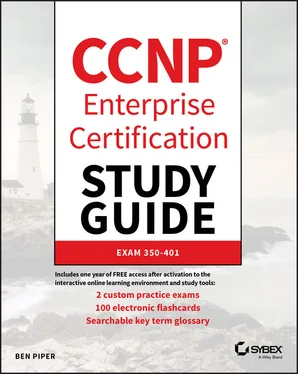Chapter 6: Enhanced Interior Gateway Routing Protocol (EIGRP)This chapter covers advanced EIGRP concepts, including redistribution, multipathing, and path control.
Chapter 7: The Border Gateway Protocol (BGP)In this chapter, you'll learn all about BGP, including path selection, redistribution, summarization, and filtering.
Chapter 8: Network Address Translation and MulticastThis two-for-the-price-of-one chapter gives you complete coverage of network address translation and multicast.
Chapter 9: Quality of ServiceThis chapter covers QoS concepts, including queuing, policing, shaping, and classification.
Chapter 10: Network VirtualizationThis chapter dives deep into virtualization concepts such as server virtualization, network virtualization, generic routing encapsulation, IPsec, LISP, and VXLAN.
Chapter 11: Software-Defined Networking and Network ProgrammabilityIn this chapter, you'll learn about Cisco's software-defined networking (SDN) solutions, SD-Access, Cisco DNA Center, and SD-WAN. You'll also learn about network automation tools such as Python, RESTCONF, NETCONF, Ansible, Chef, Puppet, and SaltStack.
Chapter 12: Network Security and MonitoringThis chapter will show you how to implement infrastructure security best practices and wireless security configurations. You'll also learn about Cisco security products and how to monitor your network using NetFlow, IPSLA, debugs, Syslog, SNMP, and more.
Interactive Online Learning Environment and Test Bank
The interactive online learning environment that accompanies this CCNP Enterprise Certification Study Guide: Exam 350-401 provides a test bank with study tools to help you prepare for the certification exam—and increase your chances of passing it the first time! The test bank includes the following:
Sample TestsAll the questions in this book are provided, including the assessment test at the end of this introduction and the chapter tests that include the review questions at the end of each chapter. In addition, there are two practice exams with 50 questions each. Use these questions to test your knowledge of the study guide material. The online test bank runs on multiple devices.
FlashcardsThe online text banks include 100 flashcards specifically written to hit you hard, so don't get discouraged if you don't ace your way through them at first. They're there to ensure that you're really ready for the exam. And no worries—armed with the review questions, practice exams, and flashcards, you'll be more than prepared when exam day comes. Questions are provided in digital flashcard format (a question followed by a single correct answer). You can use the flashcards to reinforce your learning and provide last-minute test prep before the exam.
Other Study ToolsA glossary of key terms from this book is available as a fully searchable PDF.
 Go to www.wiley.com/go/sybextestprepto register and gain access to this interactive online learning environment and test bank with study tools.
Go to www.wiley.com/go/sybextestprepto register and gain access to this interactive online learning environment and test bank with study tools.
The CCNP ENCOR exam is intended for people who have experience implementing enterprise network technologies including IPv4 and IPv6 architecture, virtualization, monitoring, security, and automation. In general, you should have the following before taking the exam:
A minimum of two years of hands-on experience configuring and troubleshooting routers and switches
Ability to design and configure a network based on customer requirements
Ability to provide implementation guidance
A mastery of IPv4 and IPv6
The exam covers six different domains, with each domain broken down into objectives.
The following table lists each domain and its weighting in the exam, along with the chapters in the book where that domain's objectives are covered.
| Domain |
Percentage of exam |
Chapter |
| Domain 1: Architecture |
15% |
|
| 1.1 Explain the different design principles used in an enterprise network |
|
1, 3 |
| 1.2 Analyze design principles of a WLAN deployment |
|
4 |
| 1.3 Differentiate between on-premises and cloud infrastructure deployments |
|
11 |
| 1.4 Explain the working principles of the Cisco SD-WAN solution |
|
11 |
| 1.5 Explain the working principles of the Cisco SD-Access solution |
|
11 |
| 1.6 Describe concepts of wired and wireless QoS |
|
9 |
| 1.7 Differentiate hardware and software switching mechanisms |
|
1 |
| Domain 2: Virtualization |
10% |
|
| 2.1 Describe device virtualization technologies |
|
10 |
| 2.2 Configure and verify data path virtualization technologies |
|
10 |
| 2.3 Describe network virtualization concepts |
|
10 |
| Domain 3: Infrastructure |
30% |
|
| 3.1 Layer 2 |
|
1, 2, 3 |
| 3.2 Layer 3 |
|
1, 5, 6, 7 |
| 3.3 Wireless |
|
4 |
| 3.4 IP Services |
|
3, 8, 12 |
| Domain 4: Network Assurance |
10% |
|
| 4.1 Diagnose network problems using tools such as debugs, conditional debugs, trace route, ping, SNMP, and syslog |
|
12 |
| 4.2 Configure and verify device monitoring using syslog for remote logging |
|
12 |
| 4.3 Configure and verify NetFlow and Flexible NetFlow |
|
12 |
| 4.4 Configure and verify SPAN/RSPAN/ERSPAN |
|
12 |
| 4.5 Configure and verify IPSLA |
|
12 |
| 4.6 Describe Cisco DNA Center workflows to apply network configuration, monitoring, and management |
|
11 |
| 4.7 Configure and verify NETCONF and RESTCONF |
|
11 |
| Domain 5: Security |
20% |
|
| 5.1 Configure and verify device access control |
|
12 |
| 5.2 Configure and verify infrastructure security features |
|
12 |
| 5.3 Describe REST API security |
|
11 |
| 5.4 Configure and verify wireless security features |
|
4, 12 |
| 5.5 Describe the components of network security design |
|
4, 12 |
| Domain 6: Automation |
15% |
|
| 6.1 Interpret basic Python components and scripts |
|
11 |
| 6.2 Construct valid JSON encoded file |
|
11 |
| 6.3 Describe the high-level principles and benefits of a data modeling language, such as YANG |
|
11 |
| 6.4 Describe APIs for Cisco DNA Center and vManage |
|
11 |
| 6.5 Interpret REST API response codes and results in payload using Cisco DNA Center and RESTCONF |
|
11 |
| 6.6 Construct EEM applet to automate configuration, troubleshooting, or data collection |
|
11 |
| 6.7 Compare agent vs. agentless orchestration tools, such as Chef, Puppet, Ansible, and SaltStack |
|
11 |
Читать дальше

 Go to www.wiley.com/go/sybextestprepto register and gain access to this interactive online learning environment and test bank with study tools.
Go to www.wiley.com/go/sybextestprepto register and gain access to this interactive online learning environment and test bank with study tools.










